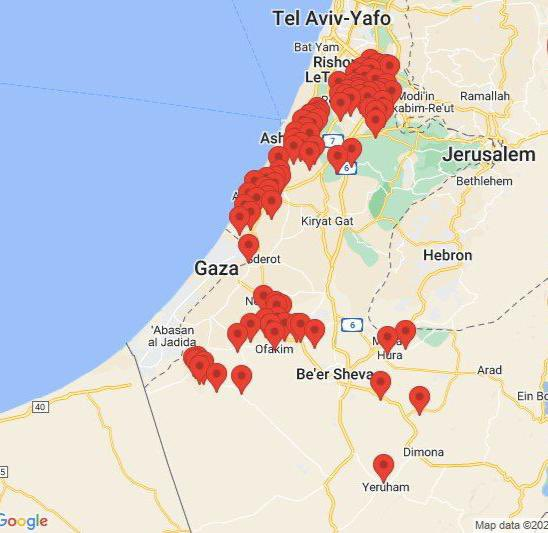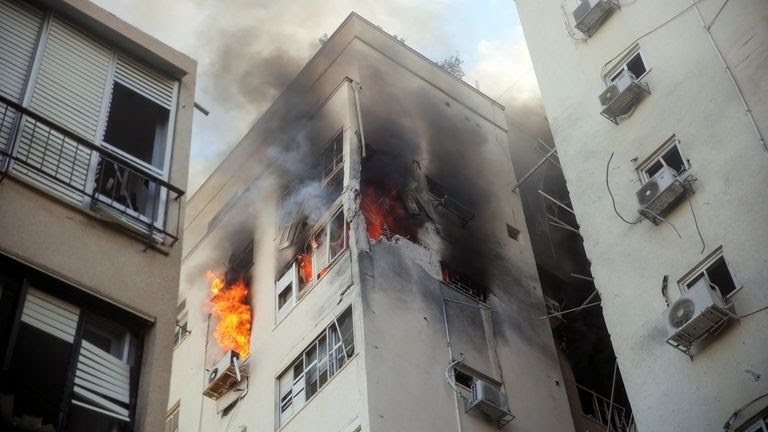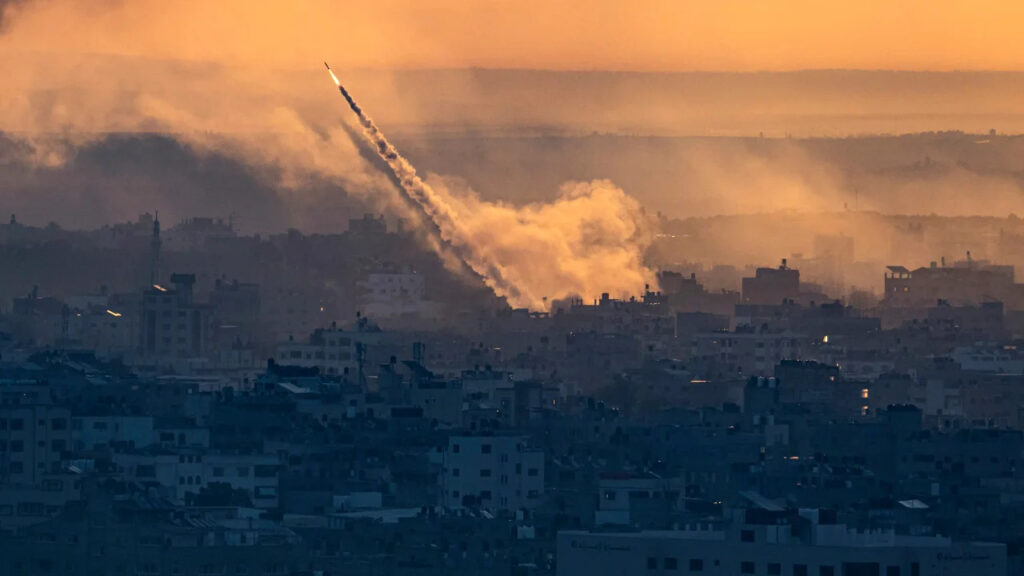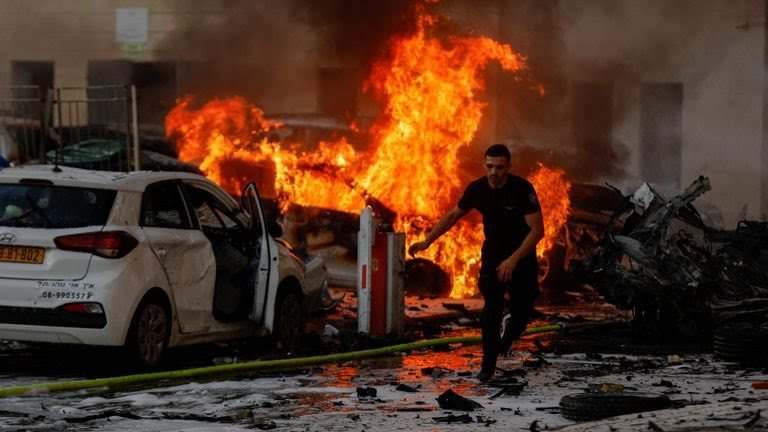the escalating conflict between Israel and Gaza, examining its historical context, the human toll, and international responses. Explore the complexities of the Middle East crisis and the quest for peace amid a tumultuous backdrop.
The Middle East once again became the epicenter of global attention as Israel found itself thrust into a state of war. On a fateful Saturday, Prime Minister Benjamin Netanyahu issued a resolute declaration following a major escalation in the long-standing conflict with Palestinian militants in Gaza. The region was thrust into chaos as Palestinian militants unleashed a devastating barrage of rockets and infiltrated Israeli territory, marking one of the most significant escalations in recent history.
The Israeli military, in an initial assessment, reported an astonishing 2,200 rockets launched from the Gaza Strip into Israel. This ferocious onslaught was complemented by armed terror groups utilizing unconventional means to infiltrate Israeli territory, including by land, sea, and even paragliders. The consequence was a relentless barrage of explosions echoing over Jerusalem, Tel Aviv, and southern Israel. In the face of imminent danger, Israeli citizens sought refuge in underground shelters, a haunting echo of a nation’s resilience in the face of adversity.
The Israel Defense Forces (IDF) reluctantly disclosed that Hamas, the militant organization ruling Gaza, had taken hostages and prisoners of war during the attack. However, the IDF refrained from divulging precise figures, a testament to the evolving and unpredictable nature of the crisis. Tragically, the toll on the Israeli side was heart-wrenching, with at least 200 casualties and 1,452 individuals wounded, according to Israel’s emergency rescue service and health ministry. Innumerable families were shattered, and a nation was left to mourn.
In response to the unrelenting assault, Israel swiftly launched counter-strikes, targeting what it identified as Hamas strongholds within Gaza. Among the casualties of these retaliatory strikes was the Palestine Tower, a prominent high-rise building in Gaza City. This tower, which hosted residential apartments and media offices, was engulfed in a massive explosion, captured in real-time by numerous cameras. The resultant collapse sent shockwaves not only through Gaza but across the world as images of destruction and chaos flooded the media.
On the Palestinian side, the Ministry of Health reported a staggering 232 Palestinian casualties and 1,697 injuries. However, these numbers, while reflective of the grim reality, lacked the granularity to distinguish between Hamas militants and innocent civilians caught in the crossfire. The question of the civilian toll weighed heavily on international conscience.
Israel
In an emotionally charged televised address, Prime Minister Netanyahu vowed severe retribution against Hamas, a familiar adversary that had plunged the region into turmoil once again. Netanyahu declared, “What happened today has never been seen in Israel; we will take mighty vengeance for this black day,” a sentiment that resonated with the collective resolve of a nation under siege. With a stern and unwavering tone, he warned Hamas, holding them unequivocally responsible for the well-being of the captives.
The Prime Minister, resolute in his commitment to protect his nation, pledged to turn Hamas-associated locations into what he ominously termed “islands of ruins.” As if addressing the very soul of Gaza, he issued a stark warning to its residents, urging them to evacuate, stating, “Leave now because we will operate forcefully everywhere.” The prospect of further devastation loomed large over Gaza’s beleaguered population.

As the ordeal continued to unfold, the grim reality manifested itself in the form of a fresh round of rockets fired by Gaza militants in the evening. These projectiles made direct hits on multiple locations inside Israel, including Tel Aviv, one of the country’s most populous cities. Israeli authorities once again sounded the alarm, with air raid sirens piercing the night. The battle, it seemed, was far from over.
The armed wing of Hamas, an entity designated as a terrorist organization by the United States, the European Union, and Israel itself, responded with a statement of its own. Claiming responsibility for additional rocket launches, Hamas asserted that these attacks were in direct retaliation for the bombing of the residential tower in Gaza City. The cycle of violence, it appeared, was relentless.

The surprise assault on that fateful Saturday carried an eerie historical significance. It coincided with the 50th anniversary of the 1973 War, a conflict in which Arab states launched a surprise attack on Israel on Yom Kippur, the holiest day of the Jewish calendar. This timing added layers of complexity to an already volatile situation, evoking memories of a tumultuous past.
IDF spokesman Lt. Col. Richard Hecht, facing a barrage of questions from journalists, offered insights into the ongoing ground operations. He provided a sobering assessment, acknowledging that Israeli forces were actively engaged in ground combat. He listed multiple locations where fighting was taking place, including villages, army bases, and critical border crossings. The intensity of the clashes on the ground underscored the gravity of the situation.

Yet, even as the military juggernaut was set in motion, the specter of intelligence failures loomed large. Journalists repeatedly pressed Hecht on whether the IDF had missed crucial intelligence that could have foreshadowed the magnitude of the attack. The absence of a clear response only deepened the sense of uncertainty.

A former IDF international spokesperson, Jonathan Conricus, stepped forward to offer his perspective. In a candid assessment, he described the massive surprise attack as a “Pearl Harbor type of moment” for the country. The use of such an analogy underscored the profound shock that reverberated through Israeli society. Conricus further elaborated, suggesting that it was not just one component but the entire defense architecture that had evidently failed to provide the necessary protection for Israeli civilians. The magnitude of the intelligence and security lapses was becoming increasingly apparent.
Dubbed “Al-Aqsa Storm,” the Hamas military commander, Muhammad Al-Deif, provided a glimpse into the motivations behind the assault. In a recorded message disseminated widely, Al-Deif stated that the group had “targeted the enemy positions, airports, and military positions with 5,000 rockets.” His words carried the weight of a movement driven by grievances, responding to attacks on women, the desecration of the Al-Aqsa mosque in Jerusalem, and the ongoing siege of Gaza.
“If you have a gun, get it out. This is the time to use it Get out with trucks, cars, and axes; today the best and most honorable history starts,” Al-Deif added, invoking the spirit of resistance that had defined the Palestinian struggle for generations. His words were a rallying cry, drawing a stark contrast between the might of the Israeli military and the determination of those who felt oppressed.
The attacks by Hamas followed one of the deadliest periods in the Israeli-occupied West Bank in nearly two decades. The violence had been driven by frequent Israeli military raids in Palestinian towns and cities, which Israel argued were a necessary response to a rising number of attacks by Palestinian militants on Israelis. The cycle of violence, it seemed, had spiraled out of control.
This escalation also unfolded against a backdrop of deep division within Israel. Months earlier, the government had pushed through a contentious plan to reduce the power of the country’s courts, sparking a social and political crisis. The move had struck a nerve not only with the public but also with the military establishment, prompting many reservists, the backbone of Israel’s army, to publicly express their opposition. Their stance was clear: they would not heed the call of duty in protest against changes to the judicial system.
An IDF spokesperson, questioned about the response of reservists in the face of the latest attacks, asserted that he had no knowledge of any reservists refusing to be called up. The statement underscored the complexities of a nation grappling with internal strife while simultaneously facing an external threat of unprecedented magnitude.
As the world watched in shock and disbelief, Israel was forced to confront an assault that defied conventional warfare. Palestinian militants had breached Israel’s defenses through air, sea, and ground incursions, a feat that was exceedingly rare given the region’s isolation and the vigilant watch of Israel’s military.
The infiltration of Palestinian militants into Israeli territory from Gaza was a development that demanded scrutiny. Gaza, a densely populated coastal enclave of almost 2 million people, had been effectively sealed off from the rest of the world by an Israeli blockade that dated back to 2007. This blockade, which restricted the movement of civilians and controlled the importation of basic goods into the narrow coastal strip, had created a simmering cauldron of frustration and despair.
Egypt, controlling Gaza’s southern border crossing at Rafah, added another layer to the complex geopolitics of the region. The isolation of Gaza, a territory governed by Hamas, had created a humanitarian crisis of immense proportions. The influx of weapons and militants into Gaza remained a contentious issue, one that had the potential to ignite conflicts far beyond the borders of this besieged enclave.
The audacious video shared by Hamas’ armed wing on that tumultuous Saturday provided chilling visuals of the unprecedented incursion. The footage showed a group of fighters storming the Erez Crossing post, the main border crossing between the Gaza Strip and Israel. The video, heavily edited for maximum impact, depicted several lifeless bodies on the ground amid the deafening sounds of gunfire. It also captured the unsettling scene of individuals, their hands held on their heads, being led away by the fighters. The symbolism was stark: militants had breached the heavily fortified borders, challenging the status quo in a region marked by division and conflict.
Hamas went a step further, claiming to have captured Israeli vehicles from cities near the Gaza border. This assertion, if proven true, marked a significant escalation in the conflict. The IDF, questioned by CNN about these claims, chose not to comment, deepening the sense of mystery surrounding the extent of the incursions.
Meanwhile, reports began to emerge of hostage situations unfolding in multiple locations. In Ofakim and Beeri, uncertainty shrouded the fate of those who had been taken captive. The absence of reliable information heightened the anxiety, both within the affected communities and among observers around the world.
Videos surfaced, offering a harrowing glimpse into the reality of these hostage situations. In one video, geolocated to Gaza’s Shejaiya neighborhood, a barefoot woman was forcibly extracted from the trunk of a vehicle by an armed assailant. She was then thrust into the backseat, her face stained with blood and her wrists seemingly bound behind her back. The shocking footage raised disturbing questions about the circumstances surrounding these abductions. Notably, the vehicle involved bore an Israeli Defense Forces license plate, a detail that only deepened the sense of intrigue. How had this vehicle found its way into Gaza, and what role did it play in these dramatic events?
A second video, situated in Be’eri in southern Israel, offered a different perspective on the unfolding crisis. It suggested that Hamas militants had taken multiple Israelis captive. Desperate residents of Israeli communities near the Gaza border, such as Kibbutz Beeri and Kibbutz Nir Oz, made impassioned pleas for assistance on television. Their voices, tinged with fear and urgency, highlighted the profound human cost of the conflict. In a particularly heartbreaking account, one resident described how he and his family, including two young children aged 7 and 9, had barricaded themselves in a safe room while militants fired upon their door.
Channel 12, a prominent Israeli television station, further reported that infiltrators had taken hostages in Netiv HaAsara. However, Israeli authorities had yet to confirm specific details regarding these reports, leaving the affected communities in a state of agonizing uncertainty.
In the midst of these hostage situations, the IDF issued urgent warnings to Israelis residing near Gaza, urging them to remain indoors or seek shelter in designated safe areas. The chilling reality of a nation under siege was underscored by the need for such warnings as ordinary citizens grappled with the imminent threat to their safety.
Zaki Heller, spokesperson for Israel’s Magen David Adom, appealed to the public for blood donations, citing an urgent need to replenish dwindling supplies. The urgency of this appeal underscored the relentless demand placed on medical facilities and personnel grappling with an unprecedented crisis. A special blood donation drive was hastily organized in Tel Aviv, mobilizing the city’s residents to respond to the call for assistance.
Social media, a powerful tool in the dissemination of news and information, provided a haunting visual record of the aftermath of rocket strikes in Ashkelon. This coastal city in southern Israel had borne the brunt of the rocket attacks, with multiple vehicles engulfed in flames next to an apartment complex. Thick plumes of black smoke billowed into the air, casting an ominous shadow over a city besieged by conflict.
As the world watched with bated breath, the crisis in Israel and Gaza continued to escalate, presenting a formidable challenge to the international community. The situation was undeniably complex, with no easy solutions or quick fixes. The roots of the conflict ran deep, entangled in a web of historical grievances, political maneuvering, and regional dynamics.
Gaza, one of the most densely populated places on Earth, had become a crucible of suffering. Its residents, living in cramped conditions with limited access to basic necessities, had endured years of hardship. The blockade, imposed by Israel and supported by Egypt, had stifled economic growth, restricted the movement of people and goods, and exacerbated poverty and unemployment. It had created a pressure cooker of frustration and despair, one that had periodically erupted into violence.
Hamas, the de facto governing authority in Gaza, had maintained its grip on power despite the immense challenges it faced. The organization’s political and military wings were deeply intertwined, and its commitment to the Palestinian cause was unwavering. However, its methods had been a subject of controversy, with critics accusing it of using civilians as human shields and resorting to indiscriminate rocket attacks.
On the Israeli side, the sense of vulnerability was palpable. The rocket attacks from Gaza had struck at the heart of the country, reaching major cities like Tel Aviv and Jerusalem. The Iron Dome, a sophisticated missile defense system, had intercepted many of the incoming rockets, preventing even greater loss of life. However, no defense system was foolproof, and the rockets that did breach the defenses inflicted damage and casualties.
Prime Minister Netanyahu, facing a crisis of unprecedented proportions, had to navigate a complex set of challenges. His leadership, already under scrutiny due to domestic political turmoil, was now under an even more intense spotlight. The nation looked to him for reassurance, resolve, and a path forward in a time of uncertainty.
As the international community grappled with the crisis, world leaders responded with a mix of concern, condemnation, and calls for restraint. In the United States, President Joe Biden reaffirmed the strong and unwavering support of his administration for Israel’s security. He emphasized Israel’s right to defend itself against terrorist assaults, underscoring the deep-rooted alliance between the two countries.
Stephanie Hallett, the top American diplomat in Israel, condemned the indiscriminate rocket fire by Hamas terrorists against Israeli civilians. Her statement underscored the moral imperative to protect innocent lives, regardless of the complexities of the conflict.
In Turkey, President Recep Tayyip Erdogan called for all parties involved to exercise restraint and refrain from impulsive actions that could further escalate tensions. His call for moderation echoed the concerns of many in the international community, who feared a widening of the conflict.
Egypt, a regional power with historical ties to both Israel and the Palestinians, found itself in a delicate diplomatic position. Foreign Minister Sameh Shoukry engaged in intensive communication with international officials in a bid to halt the ongoing escalation. Egypt’s role as a mediator and stabilizing force in the region was crucial, and its efforts to de-escalate the situation were closely watched.
European leaders, too, weighed in on the crisis, utilizing social media to denounce the violence and express solidarity with those affected. European Commission President Ursula Von der Leyen unequivocally condemned the violence as terrorism in its most despicable form. Her words reflected the gravity of the situation and the need for a unified international response.
French President Emmanuel Macron expressed his full solidarity with the victims of the conflict, a sentiment shared by many around the world. German Chancellor Olaf Scholz, in a statement that echoed the sentiments of his predecessors, condemned the Hamas attacks and reaffirmed Germany’s unwavering support for Israel’s right to self-defense.
The crisis in Israel and Gaza, now unfolding on a global stage, was a stark reminder of the enduring complexities of the Middle East conflict. It was a conflict marked by deeply entrenched narratives, historical grievances, and competing visions of justice and statehood. The cycle of violence, it seemed, was destined to repeat itself unless a path to lasting peace could be forged.
The world watched as Israel and Gaza stood on the precipice of further escalation, with the fate of millions hanging in the balance. The choices made in the coming days and weeks would shape not only the immediate future of the region but also the prospects for a lasting resolution to a conflict that had defied resolution for generations.
As the international community grappled with the enormity of the crisis, one thing remained clear: the human toll of the conflict was immeasurable. Families torn apart, lives shattered, and communities left in ruins were the enduring legacy of a conflict that had exacted a heavy price for all those caught in its grip.
The path to peace, it seemed, was as elusive as ever. Yet, in the face of such adversity, the indomitable spirit of those affected by the conflict endured. Their resilience and determination served as a testament to the enduring hope that, one day, a just and lasting peace would prevail in the troubled lands of Israel and Gaza.
As the world watched and waited, the future remained uncertain, but the desire for peace, justice, and reconciliation burned brighter than ever. The story of Israel and Gaza, one of conflict and suffering, was also a story of hope and resilience in the face of overwhelming odds. It was a story that would continue to unfold as the world grappled with the complexities of a region where the past and the future were inextricably intertwined.
also read Putin’s New World
[…] also read Israel under Siege […]
[…] also read Israel and Hamas […]
[…] also read Israel and Hamas […]
[…] also read Israel and Hamas […]